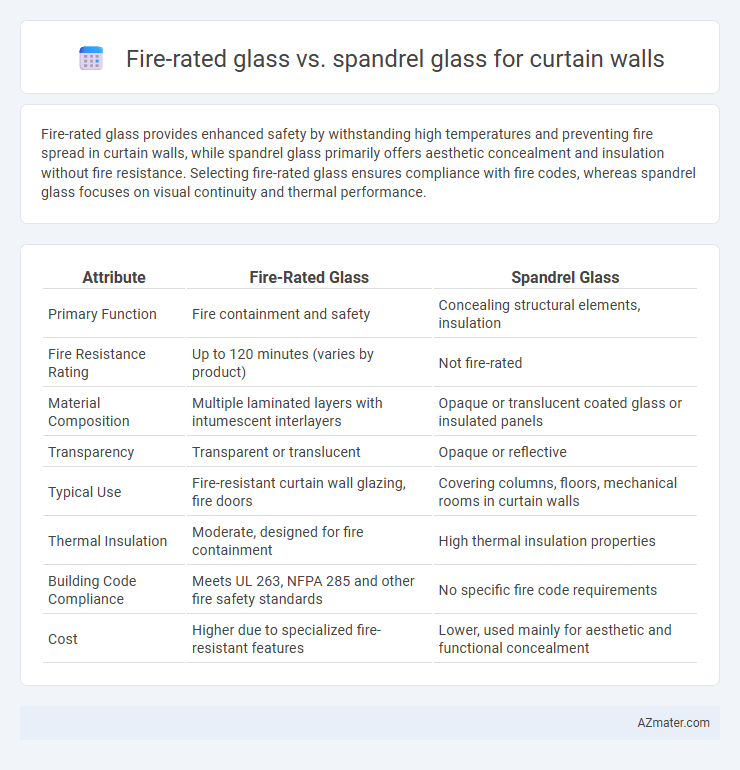Fire-rated glass provides enhanced safety by withstanding high temperatures and preventing fire spread in curtain walls, while spandrel glass primarily offers aesthetic concealment and insulation without fire resistance. Selecting fire-rated glass ensures compliance with fire codes, whereas spandrel glass focuses on visual continuity and thermal performance.
Table of Comparison
| Attribute | Fire-Rated Glass | Spandrel Glass |
|---|---|---|
| Primary Function | Fire containment and safety | Concealing structural elements, insulation |
| Fire Resistance Rating | Up to 120 minutes (varies by product) | Not fire-rated |
| Material Composition | Multiple laminated layers with intumescent interlayers | Opaque or translucent coated glass or insulated panels |
| Transparency | Transparent or translucent | Opaque or reflective |
| Typical Use | Fire-resistant curtain wall glazing, fire doors | Covering columns, floors, mechanical rooms in curtain walls |
| Thermal Insulation | Moderate, designed for fire containment | High thermal insulation properties |
| Building Code Compliance | Meets UL 263, NFPA 285 and other fire safety standards | No specific fire code requirements |
| Cost | Higher due to specialized fire-resistant features | Lower, used mainly for aesthetic and functional concealment |
Introduction to Curtain Wall Systems
Curtain wall systems rely on specialized glass types to ensure safety and aesthetic appeal in building facades. Fire-rated glass provides critical fire resistance by preventing the spread of flames and smoke, meeting stringent safety codes in high-risk areas. Spandrel glass, in contrast, conceals structural elements and insulation, offering thermal insulation and uniform exterior appearance without fire-resistant properties.
What is Fire-Rated Glass?
Fire-rated glass is specially designed to withstand high temperatures and prevent the spread of fire and smoke for a specified period, typically ranging from 20 minutes to 2 hours. It is constructed using multiple layers of tempered glass and intumescent interlayers that expand when exposed to heat, maintaining integrity and insulation during a fire event. Unlike spandrel glass, which is primarily used for aesthetic concealment in curtain walls, fire-rated glass provides critical life safety functions by protecting occupants and property in buildings.
What is Spandrel Glass?
Spandrel glass is an opaque or frosted glass panel used in curtain wall construction to conceal structural elements, insulation, and mechanical components between floors, enhancing the building's exterior aesthetics. Unlike fire-rated glass, which provides fire resistance and safety by blocking flames and heat, spandrel glass primarily serves an architectural function without fire protection capabilities. Its ability to be customized in color, texture, and translucency makes it a versatile solution for uniform facade appearance and daylight management in high-rise buildings.
Key Properties of Fire-Rated Glass
Fire-rated glass offers critical fire resistance, maintaining integrity and insulation to prevent fire and smoke spread in curtain wall systems, typically rated for 20, 45, 60, or 90 minutes. It combines specialized interlayers and coatings to withstand high temperatures while allowing natural light, unlike spandrel glass which primarily conceals structural elements and provides no fire protection. The key properties include thermal shock resistance, smoke and flame seal capabilities, and compliance with stringent fire safety standards like UL 9 and NFPA 257.
Key Properties of Spandrel Glass
Spandrel glass in curtain walls is designed primarily for aesthetic concealment and insulation, featuring opacity to hide structural elements, insulation, and mechanical systems. It possesses thermal performance with coatings or ceramic frits to enhance energy efficiency and reduce heat transmission. Fire-rated glass, by contrast, provides fire resistance by limiting heat transfer and smoke passage, a critical property absent in standard spandrel glass.
Fire Safety Performance Comparison
Fire-rated glass in curtain walls provides critical fire resistance by preventing the spread of flames and smoke, meeting stringent fire safety codes with ratings typically ranging from 20 to 120 minutes. Spandrel glass, primarily used for aesthetic and opacity purposes in curtain walls, lacks inherent fire resistance and does not contribute to compartmentalization during a fire event. Selecting fire-rated glass ensures enhanced fire safety performance, maintaining structural integrity and occupant protection in high-rise buildings.
Aesthetic and Design Flexibility
Fire-rated glass enhances curtain wall safety by integrating fire resistance without compromising transparency, offering architects the ability to maintain natural light and visual openness. Spandrel glass, often opaque and used to conceal structural elements, provides extensive design flexibility with a wide range of colors, finishes, and textures, enabling seamless aesthetic cohesion across building facades. Combining both materials allows for innovative curtain wall solutions that balance fire safety requirements with customizable visual appeal.
Energy Efficiency Considerations
Fire-rated glass in curtain walls provides essential safety by containing fire and smoke, often featuring specialized coatings that maintain thermal insulation under high temperatures. Spandrel glass, typically opaque and used to conceal building components, contributes to energy efficiency through its reflective properties and insulation, reducing solar heat gain and improving thermal performance. Selecting the appropriate glass type depends on balancing fire safety requirements with energy-saving goals in building envelope design.
Cost Implications: Fire-Rated vs Spandrel Glass
Fire-rated glass typically incurs higher costs than spandrel glass due to specialized manufacturing processes and enhanced safety certifications that comply with stringent fire resistance standards. Spandrel glass, primarily used for aesthetic purposes and concealing structural elements, offers a more cost-effective option with fewer performance requirements. Budget planning for curtain wall projects must account for the significant price differential influenced by fire-rated glass's need for UL listing and impact on installation complexity.
Best Applications and Use Cases
Fire-rated glass is ideal for curtain walls in buildings requiring enhanced fire safety, such as hospitals, schools, and high-rise residential complexes, due to its ability to withstand high temperatures and prevent fire spread. Spandrel glass excels in concealing structural elements and mechanical systems, making it the best choice for aesthetic continuity in commercial office buildings and retail facades where thermal insulation and opacity are prioritized. Selecting the right glass depends on balancing fire resistance requirements with design goals and energy efficiency standards.

Infographic: Fire-rated glass vs Spandrel glass for Curtain wall
 azmater.com
azmater.com